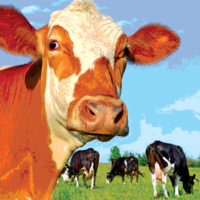A Closer Look at Reducing Antibiotic Resistance and Antibiotic Use in Food Animals

Although the importance of reducing antibiotic resistance is universally acknowledged, the details of how to identify best management practices and environmental Critical Control Points remain to be articulated. I have looked at challenges and opportunities for reducing antibiotic resistance in agricultural settings.
The first challenge we face is determining how to measure antibiotic resistance. The term “antibiotic resistance” is broadly used to refer to three main elements of resistance: drugs, bugs and genes. First there are the antibiotic drugs which are the chemicals administered to animals, added to aquaculture tanks, or sprayed on fruit crops. Next there are the “bugs”—the resistant bacteria that live in feces, soil, water and air. Finally there are the resistance genes, which are pieces of DNA that carry the genetic instructions for resistance. Usually these are carried inside of bacteria, but they can potentially persist even after a cell dies.
The issue is complicated by the fact that there are over 100 different antibiotic drugs, and resistance to each of them is encoded by multiple genes. Tetracycline resistance, for instance, can occur by three different mechanisms, and is encoded by over 25 different genes. If we want to measure or track tetracycline resistance to determine how much is there right now, and how much is it reduced over time when a particular management strategy is implemented, which one of these 25 different genes should be used?
With all this complexity, it can be expected that there will be different on-the-ground strategies and targets for the reduction of resistance in various production systems. There will be different priorities in fruit tree orchards compared to aquaculture, poultry, swine, cattle or produce production. The fact that the antibiotic drugs, resistant bacteria, and resistance genes are found in manure and soil is a common link in all systems, and an important component of how resistance might be transferred through agroecosystems to impact human health.
The solution that is most often discussed is reducing the amount of antibiotic drugs sold to and used by farmers for food production. While any reduction in the use of these drugs can potentially help, this strategy alone will not solve the problem.
That brings us to challenge number two: antibiotic resistance occurs naturally in the environment. It is easy for those not familiar with soil systems to get the impression that the natural level of antibiotic resistance is zero. That it is the human or agricultural use of the drugs that creates antibiotic resistance. This is not the case. Antibiotic drugs come from soil bacteria, and the soil is a natural reservoir of resistance across the globe. The reservoir of resistance in the soil is called the soil “resistome,” and it plays an important role in the development and spread of antibiotic resistance. Scientists have looked at resistance in both agricultural and pristine settings like native prairies, Antarctic lakes, and the Sargasso Sea. Antibiotic resistance genes can be found in all of these places. Even this naturally occurring resistance is a great concern, and the environment is an important component in how resistance might impact human health outcomes.
The fact that antibiotic resistance can occur naturally, and that the soil and environment are significant reservoirs brings us to the third and most important challenge—how to determine baseline levels of the drug, bug, or gene we are measuring, and how to sort out the resistance that can be impacted by best management practices from the resistance that is naturally present in any particular system.
One opportunity for having a positive impact on limiting the spread of resistant bacteria and genes is through manure management strategies. Treatments that reduce pathogens and general fecal bacterial numbers will also impact some antibiotic resistant bacteria, and may also reduce the persistence of antibiotic resistance genes. We need to evaluate existing strategies for this potential.
The issue of agricultural antibiotic use is starting to focus attention on the impact that soil and water systems have on human health. In the words of Dr. Cray, an international expert on the surveillance of antibiotic resistance in foodborne pathogens “the circulation of bacteria between animals, environment, humans – and back again in no particular order confounds the analysis of what begins where, who is responsible for what, and how resistance can be controlled best.”
The environment plays a key role in the transmission of antibiotic resistance through agroecosystems. A second opportunity for us as a community is to develop standards for measuring the drugs, bugs and genes in complex food and environmental samples in a way that allows us to coordinate our individual efforts while simultaneously protecting our individual interests. This can be done by building a network of independent scientists who are using validated, quality controlled methods, and moving the focus of our combined efforts to understanding the ecology of antibiotic resistance farm to fork.
Lisa Durso, Ph.D., is a research microbiologist with the United States Department of Agriculture, Agricultural Research Service, Agroecosystem Management Research Unit and a member of the Soil Science Society of America. She can be reached at lisa.durso@ars.usda.gov.
Looking for a reprint of this article?
From high-res PDFs to custom plaques, order your copy today!








